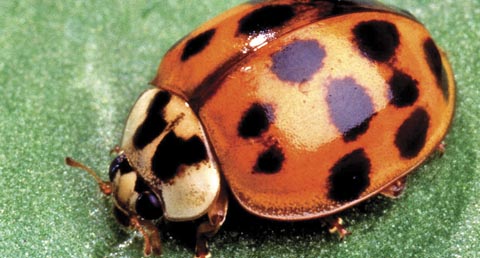
The multicolored Asian lady beetle (Harmonia axyridis) is a voracious predator, feeding on aphids as well as other pests. According to information compiled by Minnesota State University entomologists R.L. Koch and W.D. Hutchinson, adults are known to feed on up to 65 aphids per day. When prey is scarce, the lady beetle will feed on pollen and nectar.
Though lady beetles are usually desired in integrated pest management programs because of their appetite for aphids, this cousin of the common lady beetle has become a pest in vineyards because it can taint wines and juices with off flavors. When the lady beetle is disturbed, it defends itself by excreting a yellow-orange body fluid known as reflex bleeding. This blood has a very foul odor and can stain walls and clothing. Some homeowners have had problems of infestations.
The lady beetle congregates on late-season fruits, like grapes, and is difficult to remove from the clusters during harvest. When they are present during crush, they contaminate the juice. No insecticides are currently labeled to control the lady beetle.
A cousin to the common lady beetle is wreaking havoc on grape production in eastern United States and Canada, and could potentially do the same damage in vineyards in Pacific states and provinces.
The multicolored Asian lady beetle was introduced into the United States as a biological control method for aphids on pecans. The first established population was recorded in Louisiana in 1988. Since then, the lady beetle has spread rapidly throughout northeastern states and into eastern Canada.
Dr. Carolyn Ross, of Washington State University’s food science and human nutrition department, said that the multicolored Asian lady beetle is distinguished from its smaller cousin, known by many as ladybugs, by its size and by a dark marking in the shape of an ‘M’ behind its head. It is also distinguished by its odor.
“The detrimental consequence of the lady beetle is that it releases an olfactory compound that is very odorous and objectionable and affects the grape quality,” she explained.
In short, if enough lady beetles come in on grapes from the field and are crushed, they can negatively impact the grape juice aroma and flavor.
The lady beetles have not yet impacted Concord grape harvest in Washington, nor have they reached the high populations found on the East Coast, where counts of 20 to 50 multicolored Asian lady beetles per cluster have been reported. However, the species is present in the Yakima Valley. So far, they seem to prefer corn over Concord grapes.
Research
In Ross’s research project, she is studying the number of lady beetles per cluster it takes to impact Concord juice quality. Sensory panels are used in the research to help identify threshold concentrations-the minimum level of lady beetles in the juice that can be detected. Research conducted in Canada on white wine has shown that some people detected a difference when one lady beetle was added to the grape must during winemaking.
Lady beetles were collected from local Yakima Valley corn fields and added in different concentrations during the juice-making process, ranging from 0.5 to 1.5 to 4.5 lady beetles per liter. The juice was processed and pasteurized and then analyzed for compounds responsible for the odor and aroma. Juice made without lady beetles was used for the control.
Ross noted that gas chromatography identified methylanthranilate in the juice, a compound already present in Concord juice that is attributed to the “foxy” smell associated with Concord grapes.
Researchers in Canada identified a different compound–methoxypyrazine–in their white wine studies.
Ross said that in sensory evaluations, 30 percent of the 18 untrained panelists were sensitive to the aroma of juice containing lady beetles. Panelists could detect minute concentrations of lady beetles added to the juice, as low as 1.6 lady beetles per liter. As a group, the average panelist could detect a difference in the juice when 1.8 lady beetles per liter had been added.
Panelists remarked that the juice with the lady beetles had a “dirty,” “musty,” and “earthy” aroma. Canadian panelists have described the lady beetle-treated white wine as having asparagus, green pepper, and green smells.
“We originally believed that the lady beetle concentration that could be detected would be a higher number due to the Concord grape characteristics,” Ross said.
Future research will look to answer additional questions, including differences between smell and aroma of grape juice and wine that has been laced with the multicolored Asian lady beetle.

Leave A Comment